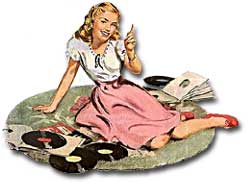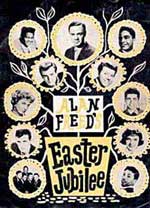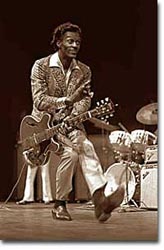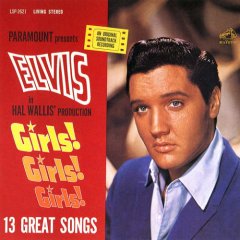53d. America Rocks and Rolls

The prosperity of the '50s allowed teenagers to spend money on records by their favorite bands and singers.
Rock and roll was everything the suburban 1950s were not. While parents of the decade were listening to Frank Sinatra, Perry Como, and big bands, their children were moving to a new beat.
In fact, to the horror of the older generation, their children were twisting, thrusting, bumping, and grinding to the sounds of rock and roll.
This generation of youth was much larger than any in recent memory, and the prosperity of the era gave them money to spend on records and phonographs. By the end of the decade, the phenomenon of rock and roll helped define the difference between youth and adulthood.
The Roots of Rock

Alan Freed, the Cleveland disc jockey credited with coining the phrase "rock and roll," was the master of ceremonies at many of the first rock concerts, including his 1955 Easter Jubilee.
The roots of rock and roll lay in African American blues and gospel. As the Great Migration brought many African Americans to the cities of the north, the sounds of rhythm and blues attracted suburban teens. Due to segregation and racist attitudes, however, none of the greatest artists of the genre could get much airplay.
Disc jockey Alan Freed began a rhythm-and-blues show on a Cleveland radio station. Soon the audience grew and grew, and Freed coined the term "rock and roll."
Early attempts by white artists to cover R&B songs resulted in weaker renditions that bled the heart and soul out of the originals. Record producers saw the market potential and began to search for a white artist who could capture the African American sound.

Chuck Berry's songs about girls and cars hit a nerve with American teens and sent his star rising high in the early days of rock and roll.
Sam Phillips, a Memphis record producer, found the answer in Elvis Presley. With a deep Southern sound, pouty lips, and gyrating hips, Elvis took an old style and made it his own.
From Memphis, the sound spread to other cities, and demand for Elvis records skyrocketed. Within two years, Elvis was the most popular name in the entertainment business.
After the door to rock and roll acceptance was opened, African American performers such as Chuck Berry, Fats Domino, and Little Richard began to enjoy broad success, as well. White performers such as Buddy Holly and Jerry Lee Lewis also found artistic freedom and commercial success.
Satan's Music

Elvis Presley brought rock-and-roll music to the masses during the 1950s with hits such as "Love Me Tender" and "Heartbreak Hotel."
Rock and roll sent shockwaves across America. A generation of young teenagers collectively rebelled against the music their parents loved. In general, the older generation loathed rock and roll. Appalled by the new styles of dance the movement evoked, churches proclaimed it Satan's music.
Because rock and roll originated among the lower classes and a segregated ethnic group, many middle-class whites thought it was tasteless. Rock and roll records were banned from many radio stations and hundreds of schools.
But the masses spoke louder. When Elvis appeared on TV's The Ed Sullivan Show, the show's ratings soared.
|
Rock and roll is the most brutal, ugly, degenerate, vicious form of expression — lewd, sly, in plain fact, dirty — a rancid-smelling aphrodisiac and the martial music of every side-burned delinquent on the face of the earth. – Frank Sinatra (1957) | ||
The commercial possibilities were limitless. As a generation of young adults finished military service, bought houses in suburbia, and longed for stability and conformity, their children seemed to take comfort for granted. They wanted to release the tensions that bubbled beneath the smooth surface of postwar America.
Above all, they wanted to shake, rattle, and roll.






